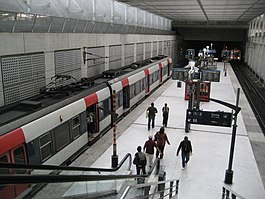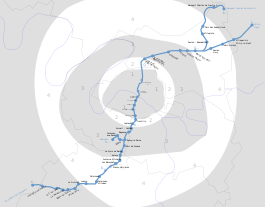
RER B
Hybrid suburban commuter and rapid transit system serving Paris, France and its suburbs. / From Wikipedia, the free encyclopedia
Dear Wikiwand AI, let's keep it short by simply answering these key questions:
Can you list the top facts and stats about RER B?
Summarize this article for a 10 years old
RER B is one of the five lines in the Réseau Express Régional (English: Regional Express Network), a hybrid commuter rail and rapid transit system serving Paris, France and its Île-de-France suburbs. The 80-kilometre (50 mi) RER B line crosses the region from north to south, with all trains serving a group of stations in central Paris, before branching out towards the ends of the line.
| RER B | |||
|---|---|---|---|
 RER B train at Charles de Gaulle Airport station | |||
| Overview | |||
| Termini |
| ||
| Stations | 47 | ||
| Service | |||
| Type | Rapid transit/commuter rail | ||
| System | Réseau Express Régional | ||
| Operator(s) | RATP/SNCF | ||
| Rolling stock | MI 79, MI 84 | ||
| Ridership | 165 million journeys per annum (2004) | ||
| History | |||
| Opened | 8 December 1977 (last extension in 1994) | ||
| Technical | |||
| Line length | 80 km (50 mi) | ||
| Track gauge | 1,435 mm (4 ft 8+1⁄2 in) standard gauge | ||
| |||
The line opened in stages starting in December 1977 by connecting two existing suburban commuter rail lines with a new tunnel under Paris: the Chemin de Fer du Nord to the north (which formerly terminated at Gare du Nord) and the Ligne de Sceaux to the south (which formerly terminated at Luxembourg station).
The RER B, along with the rest of the RER network, has had a significant social impact on Paris and the surrounding region by speeding up trips across central Paris, by making far fewer stops than the Paris Métro and by bringing far-flung suburbs within easy reach of the city centre. The line has far exceeded all traffic expectations, with passengers taking 165 million journeys per year in 2004. That makes the RER B the second busiest single rail line in Europe (after RER A).
The line faces capacity challenges as a result of sharing a tunnel with RER D trains between Châtelet–Les Halles and Gare du Nord.
